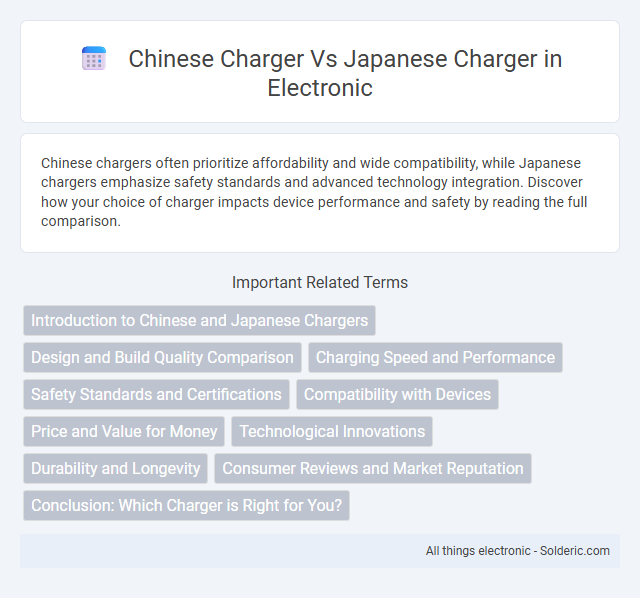Chinese chargers often prioritize affordability and wide compatibility, while Japanese chargers emphasize safety standards and advanced technology integration. Discover how your choice of charger impacts device performance and safety by reading the full comparison.
Comparison Table
| Feature | Chinese Charger | Japanese Charger |
|---|---|---|
| Plug Type | Type A, Type I | Type A, Type B |
| Voltage | 220V | 100V |
| Frequency | 50Hz / 60Hz | 50Hz / 60Hz |
| Plug Shape | Flat or angled prongs | Flat parallel prongs |
| Safety Standards | GB Standard (China) | PSE Certification (Japan) |
| Output Power | Varies; typically supports 5V to 20V | Varies; typically supports 5V to 12V |
| Compatibility | Designed for Chinese and international devices | Optimized for Japanese electronics |
| Price Range | Generally lower cost | Generally higher cost due to certification |
| Durability | Variable quality; depends on manufacturer | High quality and strict manufacturing controls |
Introduction to Chinese and Japanese Chargers
Chinese chargers often emphasize affordability and compatibility with a wide range of devices, leveraging advanced manufacturing technologies to produce cost-effective yet functional power adapters. Japanese chargers prioritize high safety standards, reliable energy efficiency, and strict compliance with local electrical regulations, reflecting the country's focus on quality assurance and consumer protection. Both types incorporate varying voltage and plug designs tailored to their respective domestic markets, influencing international compatibility and user preferences.
Design and Build Quality Comparison
Chinese chargers often emphasize cost-efficiency and mass production, resulting in variable design consistency and materials that may feel less durable. Japanese chargers prioritize meticulous craftsmanship and high-quality components, ensuring a reliable build that excels in safety and longevity. Your choice between these can impact device protection and charging performance.
Charging Speed and Performance
Chinese chargers often incorporate fast-charging technologies like Qualcomm Quick Charge and USB Power Delivery, providing rapid charging speeds compatible with various devices. Japanese chargers emphasize high build quality and efficiency, ensuring stable power output and overall reliable performance. While Chinese models may offer faster peak charging, Japanese chargers typically deliver consistent and safe energy transfer, minimizing risks of overheating or battery damage.
Safety Standards and Certifications
Chinese chargers often comply with standards such as CCC (China Compulsory Certification) and GB safety regulations, which ensure basic safety and electromagnetic compatibility for electronics within China. Japanese chargers typically adhere to more stringent certifications like PSE (Product Safety Electrical Appliance & Material) mark and JIS (Japanese Industrial Standards), reflecting rigorous testing for electrical safety, fire resistance, and user protection. The difference in regulatory frameworks impacts the overall safety reliability, with Japanese chargers generally subjected to higher accountability and quality control measures.
Compatibility with Devices
Chinese chargers often provide wide compatibility with various devices due to adopting universal standards like USB Power Delivery and Quick Charge protocols. Japanese chargers typically emphasize device-specific optimization, ensuring optimal charging efficiency and safety for domestic electronic brands such as Sony and Panasonic. Compatibility challenges may arise when using Japanese chargers abroad because of different voltage and plug types, whereas Chinese chargers generally support broader international use.
Price and Value for Money
Chinese chargers typically offer lower prices due to mass production and lower manufacturing costs, making them attractive for budget-conscious consumers. Japanese chargers emphasize higher quality, durability, and safety standards, often justifying their premium price with better long-term value and reliability. Your choice depends on whether upfront cost savings or sustained performance and safety are more important factors.
Technological Innovations
Chinese chargers often incorporate advanced GaN (Gallium Nitride) technology, enabling faster charging speeds and improved energy efficiency compared to traditional silicon-based Japanese chargers. Japanese chargers typically emphasize stringent safety standards and durability, with innovations in temperature control and power management systems. Your choice between Chinese and Japanese chargers may depend on whether you prioritize cutting-edge fast charging capabilities or robust safety features.
Durability and Longevity
Chinese chargers often prioritize affordability, which can sometimes result in lower durability compared to Japanese chargers known for superior build quality and rigorous manufacturing standards. Japanese chargers typically use higher-grade components and undergo strict quality control, enhancing their longevity and reliability under prolonged usage. Users seeking durable and long-lasting charging solutions generally benefit more from Japanese chargers due to their consistent performance and safety certifications.
Consumer Reviews and Market Reputation
Chinese chargers often receive praise for their affordability and wide compatibility but face criticism regarding durability and safety standards, as reflected in numerous consumer reviews. Japanese chargers are renowned for their high quality, strict adherence to safety regulations, and reliability, earning a strong market reputation among tech enthusiasts. Your choice may depend on prioritizing cost-effectiveness or trusted brand performance backed by consistent positive feedback.
Conclusion: Which Charger is Right for You?
Chinese chargers often offer affordability and a wide range of models with fast-charging technology, while Japanese chargers prioritize safety, high-quality components, and strict manufacturing standards. If budget and compatibility with various devices are key factors, a Chinese charger may suit your needs; however, for long-term durability and stringent safety certifications, a Japanese charger is typically more reliable. Assessing your priorities for cost, safety, and device compatibility will help determine the best choice between Chinese and Japanese chargers.
Chinese charger vs Japanese charger Infographic

 solderic.com
solderic.com